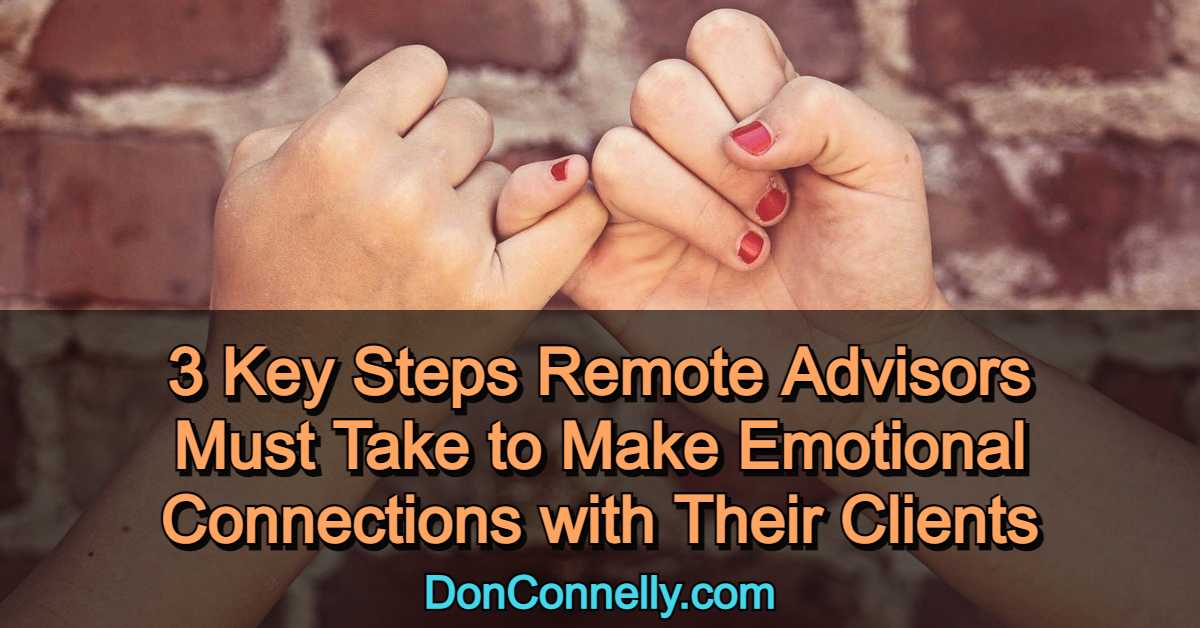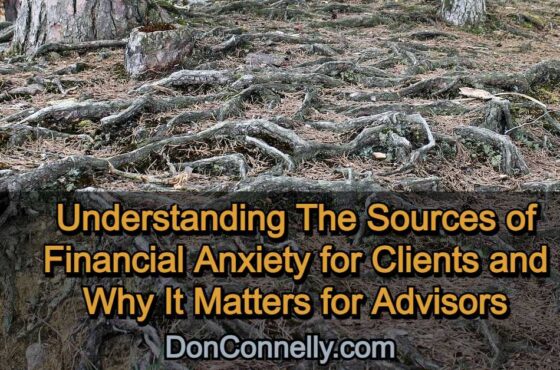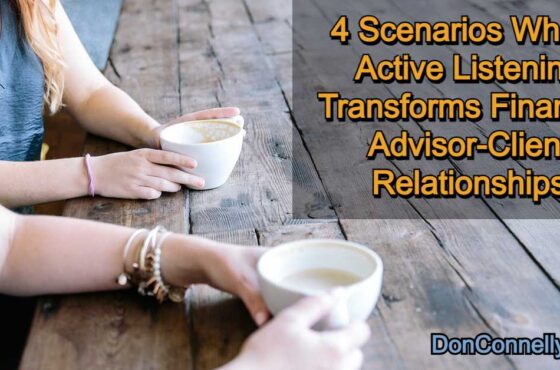3 Key Steps Remote Advisors Must Take to Make Emotional Connections with Clients
 Now that the pandemic is waning, many advisors are choosing to continue working remotely, finding that it increases their efficiency and that their clients enjoy the convenience of virtual communication. Many advisors and clients alike also enjoy the flexibility of a remote relationship. It appears that, on the surface, this new advisory model can be a win-win for advisors and their clients.
Now that the pandemic is waning, many advisors are choosing to continue working remotely, finding that it increases their efficiency and that their clients enjoy the convenience of virtual communication. Many advisors and clients alike also enjoy the flexibility of a remote relationship. It appears that, on the surface, this new advisory model can be a win-win for advisors and their clients.
While that is sure to change the advisor-client dynamic, one thing that won’t change is the need for advisors to make an emotional, personal connection with their new clients as a prerequisite for an enduring relationship. But just how do advisors accomplish that virtually?
While the same things that can be said in person can be said virtually, there’s still a physical distance that needs to be made up. Virtual eye contact is not the same as physical eye contact. There’s a virtual buffer that diminishes the personal presence people feel. Without being able to see the full range of a person’s body language, how do you know if you are making an emotional connection?
Working remotely, emotional bonding is more important than ever.
We’ve discussed the critical importance of making that emotional connection with clients, without which there is no attachment, nothing to prevent your clients from bailing when the going gets tough. Clients don’t make big decisions based on the numbers. They base them on how they feel about you. If they don’t feel you have anything to offer on an emotional level, they’ll find an advisor who does.
We know based on the data that emotionally connected clients are more valuable to their advisors. They follow their advisor’s advice, buy more products and services, are less concerned about fees, and are more willing to refer their advisors to friends and colleagues. So, it’s not something to take lightly as you set up camp remotely. In fact, you have to compensate for the physical challenges of a remote relationship by making it a focal point of your practice.
Here are three key steps to follow to maintain your focus on the emotional connection when interacting with your clients from afar:
#1. Learn about your clients’ personal relationships
Emotional connections are made through the personal conversations we have with people, and nothing connects more solidly than conversations about who we care about. It’s easy to ask, “Hey, how are the grandkids?” But, if you really want to show you care, ask, “How are Ethan and Jenna.” That makes it personal, and it triggers emotional bonding.
#2. Create a complete dossier on each clients’ meaningful relationships
To have such a conversation, you’ll need to gather all the information you can on your clients’ most valued relationships. You may already have some of that information through your discovery sessions and past conversations. You may know the names of their spouses and children. Dig deeper to learn about other meaningful relationships, such as parents, grandchildren, close friends, colleagues, and even pets.
In addition to their names, you need to know something about them, including their interests and why they’re important to your clients. That way, you can trigger more emotional bonding when you ask, “How did Ethan do at his last track meet?”
You aren’t likely to learn everything at once but, instead, in conversations with your clients over time. With each call, make it a point to gather one or two new pieces of information.
#3. Be spontaneous when using this information
Before initiating a call with your client, take a moment to review their dossier, focusing on a relationship that may be top of mind with them. Every time you call your client, be sure to start by asking about a family member or friend and remember to use their names. Maintain your notes for each client by adding new tidbits about what’s going on in their lives.
While it’s essential to incorporate this information in your scheduled calls, make a point of making periodic “just because” calls too. No business allowed. It can be a follow-up to a conversation you had in which your clients told you about an upcoming event for their spouse or kids. Check in to see how it went. Follow-up on any medical news, letting your client know you’re thinking about them. Those are the calls clients appreciate and remember most.
#4. Bonus tip: Send a note
As a follow-up to any of your calls in which clients expressed concerns over a loved one or excitement of an upcoming family event, send a handwritten note stuffed in a handwritten envelope, letting them know you’re thinking of them.
With every opportunity to engage with your clients on a personal level, you’re building emotional connections, conveying to them that you’re a good listener and care about things that are important to them. This can be done as effectively through remote conversations as it can face-to-face. However, being remote, it would be essential to make it a key ingredient of all your interactions.
Watch this 3-minute video to learn how our 24-step training program will help you develop the verbal competence, attitude and soft skills needed to attract and maintain clients, to educate, inspire and influence people into making smart decisions.
See program details and enroll today!
Available as a self-paced program (always open) and as a 12-week coaching program (opened only a few times a year), this training will change the way you view your practice and help you reach new heights. Select a format and join today!



